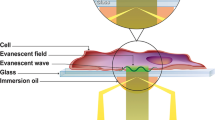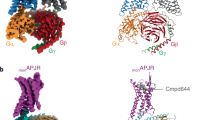Abstract
Neurotrophins (NTs) are important regulators for the survival, differentiation and maintenance of different peripheral and central neurons. NTs bind to two distinct classes of glycosylated receptor: the p75 neurotrophin receptor (p75NTR) and tyrosine kinase receptors (Trks). Whereas p75NTR binds to all NTs, the Trk subtypes are specific for each NT1,2. The question of whether NTs stimulate p75NTR by inducing receptor homodimerization is still under debate. Here we report the 2.6-Å resolution crystal structure of neurotrophin-3 (NT-3) complexed to the ectodomain of glycosylated p75NTR. In contrast to the previously reported asymmetric complex structure, which contains a dimer of nerve growth factor (NGF) bound to a single ectodomain of deglycosylated p75NTR (ref. 3), we show that NT-3 forms a central homodimer around which two glycosylated p75NTR molecules bind symmetrically. Symmetrical binding occurs along the NT-3 interfaces, resulting in a 2:2 ligand–receptor cluster. A comparison of the symmetrical and asymmetric structures reveals significant differences in ligand–receptor interactions and p75NTR conformations. Biochemical experiments indicate that both NT-3 and NGF bind to p75NTR with 2:2 stoichiometry in solution, whereas the 2:1 complexes are the result of artificial deglycosylation. We therefore propose that the symmetrical 2:2 complex reflects a native state of p75NTR activation at the cell surface. These results provide a model for NTs-p75NTR recognition and signal generation, as well as insights into coordination between p75NTR and Trks.
This is a preview of subscription content, access via your institution
Access options
Subscribe to this journal
Receive 51 print issues and online access
$199.00 per year
only $3.90 per issue
Buy this article
- Purchase on Springer Link
- Instant access to full article PDF
Prices may be subject to local taxes which are calculated during checkout




Similar content being viewed by others
References
Schweigreiter, R. The dual nature of neurotrophins. BioEssays 28, 583–594 (2006)
Bothwell, M. Functional interactions of neurotrophins and neurotrophin receptors. Annu. Rev. Neurosci. 18, 223–253 (1995)
He, X. L. & Garcia, K. C. Structure of nerve growth factor complexed with the shared neurotrophin receptor p75. Science 304, 870–875 (2004)
Nykjaer, A., Willnow, T. E. & Petersen, C. M. p75NTR—live or let die. Curr. Opin. Neurobiol. 15, 49–57 (2005)
Aurikko, J. P. et al. Characterization of symmetric complexes of nerve growth factor and the ectodomain of the pan-neurotrophin receptor, p75NTR . J. Biol. Chem. 280, 33453–33460 (2005)
Banner, D. W. et al. Crystal structure of the soluble human 55 kd TNF receptor–human TNFβ complex: implications for TNF receptor activation. Cell 73, 431–445 (1993)
Mongkolsapaya, J. et al. Structure of the TRAIL–DR5 complex reveals mechanisms conferring specificity in apoptotic initiation. Nature Struct. Biol. 6, 1048–1053 (1999)
Butte, M. J., Hwang, P. K., Mobley, W. C. & Fletterick, R. J. Crystal structure of neurotrophin-3 homodimer shows distinct regions are used to bind its receptors. Biochemistry 37, 16846–16852 (1998)
McInnes, C. & Sykes, B. D. Growth factor receptors: structure, mechanism, and drug discovery. Biopolymers 43, 339–366 (1997)
Wiesmann, C., Ultsch, M. H., Bass, S. H. & de Vos, A. M. Crystal structure of nerve growth factor in complex with the ligand-binding domain of the TrkA receptor. Nature 401, 184–188 (1999)
Wehrman, T. et al. Structural and mechanistic insights into nerve growth factor interactions with the TrkA and p75 receptors. Neuron 53, 25–38 (2007)
Rodriguez-Tebar, A., Dechant, G., Gotz, R. & Barde, Y. A. Binding of neurotrophin-3 to its neuronal receptors and interactions with nerve growth factor and brain-derived neurotrophic factor. EMBO J. 11, 917–922 (1992)
Helenius, A. & Aebi, M. Intracellular functions of N-linked glycans. Science 291, 2364–2369 (2001)
Baribault, T. J. & Neet, K. E. Effects of tunicamycin on NGF binding and neurite outgrowth in PC12 cells. J. Neurosci. Res. 14, 49–60 (1985)
He, X., Chow, D., Martick, M. M. & Garcia, K. C. Allosteric activation of a spring-loaded natriuretic peptide receptor dimer by hormone. Science 293, 1657–1662 (2001)
Ullrich, A. & Schlessinger, J. Signal transduction by receptors with tyrosine kinase activity. Cell 61, 203–212 (1990)
Reichardt, L. F. Neurotrophin-regulated signalling pathways. Phil. Trans. R. Soc. B 361, 1545–1564 (2006)
Barker, P. A. High affinity not in the vicinity? Neuron 53, 1–4 (2007)
Otwinowski, Z. & Minor, W. Processing of X-ray diffraction data collected in oscillation mode. Methods Enzymol. 276, 307–326 (1997)
Vagin, A. & Teplyakov, A. MOLREP: an automated program for molecular replacement. J. Appl. Cryst. 30, 1022–1025 (1997)
Project, C. C. The CCP4 suite: programs for protein crystallography. Acta Crystallogr. D Biol. Crystallogr. 50, 760–763 (1994)
Emsley, P. & Cowtan, K. Coot: model-building tools for molecular graphics. Acta Crystallogr. D Biol. Crystallogr. 60, 2126–2132 (2004)
Murshudov, G. N., Vagin, A. A. & Dodson, E. J. Refinement of macromolecular structures by the maximum-likelihood method. Acta Crystallogr. D Biol. Crystallogr. 53, 240–255 (1997)
Delano, W. L. The PyMOL Molecular Graphics System, DeLano Scientific, San Carlos, CA, USA. (2002)
Gouet, P., Courcelle, E., Stuart, D. I. & Metoz, F. ESPript: analysis of multiple sequence alignments in PostScript. Bioinformatics 15, 305–308 (1999)
Terwilliger, T. C. Maximum-likelihood density modification. Acta Crystallogr. D Biol. Crystallogr. 56, 965–972 (2000)
Laskowski, R. A., MacArthur, M. W., Moss, D. S. & Thornton, J. M. PROCHECK: a program to check the stereochemical quality of protein structures. J. Appl. Crystallogr. 26, 283–291 (1993)
Schuck, P. Size-distribution analysis of macromolecules by sedimentation velocity ultracentrifugation and Lamm equation modeling. Biophys. J. 78, 61606–61619 (2000)
Acknowledgements
We thank X. X. Yu for help with analytical ultracentrifugation assay, and Y. Y. Chen for the BIAcore assay. We thank Genentech for the gift of recombinant human NT-3 and recombinant human NGF. This research was supported financially by the National Key Basic Research Program, the National Natural Science Foundation of China and the National High Technology Research and Development Program of China.
Author Contributions T.J. supervised the project. Y.G. expressed, purified and crystallized the complex and performed biochemical assays. P.C. determined the structure of the complex. H.J.Y. helped with its expression and purification. P.C., Y.G. and T.J. interpreted data and wrote the paper.
Author information
Authors and Affiliations
Corresponding author
Supplementary information
Supplementary Information
The file contains Supplementary Methods, Supplementary Tables 1-2 and Supplementary Figures 1-4 with Legends. (PDF 748 kb)
Rights and permissions
About this article
Cite this article
Gong, Y., Cao, P., Yu, Hj. et al. Crystal structure of the neurotrophin-3 and p75NTR symmetrical complex. Nature 454, 789–793 (2008). https://doi.org/10.1038/nature07089
Received:
Accepted:
Published:
Issue Date:
DOI: https://doi.org/10.1038/nature07089
This article is cited by
-
The human IL-17A/F heterodimer: a two-faced cytokine with unique receptor recognition properties
Scientific Reports (2017)
-
Neurotrophin Signaling and Stem Cells—Implications for Neurodegenerative Diseases and Stem Cell Therapy
Molecular Neurobiology (2017)
-
Neurotrophins and B-cell malignancies
Cellular and Molecular Life Sciences (2016)
-
Principles of antibody-mediated TNF receptor activation
Cell Death & Differentiation (2015)
-
Small-molecule modulation of neurotrophin receptors: a strategy for the treatment of neurological disease
Nature Reviews Drug Discovery (2013)
Comments
By submitting a comment you agree to abide by our Terms and Community Guidelines. If you find something abusive or that does not comply with our terms or guidelines please flag it as inappropriate.



